SEO
A Guide To Get Started

According to data from Statista, 92.1% of U.S. marketers in companies larger than 100 employees use social media marketing to achieve a wide range of goals. Marketers in the U.S. will spend $80.6 million on social media advertising in 2022.
This makes sense considering that 4.62 billion people worldwide use social media. Specifically, 26.3% use social media to find products to purchase, and 27.7% use it to find inspiration for things to do and buy.
In other words, if your company has a product or service to sell, your potential customers could be looking for a reason to buy from you and your competitors on social media.
To determine how social media affects business, you need social media analytics.
What Is Social Media Analytics?
Social media analytics offers valuable data marketers can use to measure audience growth and engagement with your business. Social media analytics allows marketers to answer various questions, including:
- What demographics make up my social media audience?
- What social networks drive the most traffic to your website?
- How well did a specific message resonate with your audience?
- How well did a particular campaign perform?
- Is social media helping you achieve specific goals for your business?
- How are my competitors using social media to reach their customers?
Ultimately, social media analytics gives marketers the insights they need to choose the right social media networks to focus their efforts upon and know what type of social media tactics will generate the best results.
What Are The Most Important Metrics To Track?
Most marketers want to know the return on investment (ROI) of their social media marketing. Does social media marketing positively impact their business’s bottom line?
For those that invest in advertising, platforms like Facebook and YouTube offer social media analytics that can show which ads and ad campaigns generate the most impressions, clicks to your website, leads, and sales.
These metrics allow marketers to invest their budget into the ad strategies that will generate the most revenue for their business.
Organic social media marketing, however, can be harder to analyze. Social networks typically offer metrics that allow you to see the following.
- How your audience has grown over time. This data can be valuable in determining what has helped you increase your followers vs. what has resulted in a loss of followers.
- The general demographic makeup of your audience. Suppose your business only sells to customers in a specific region, but 90% of your followers are not from that region. In that case, you will have to modify your tactics to attract the right demographic of followers.
- How many people see your content. To achieve increased brand awareness, you need to post the type of content that drives more impressions and reach.
- How well your audience engages with your content. You can use metrics such as likes, shares, and comments to see the types of posts that not only reach your audience but also moves them to engage with it.
- How well competitors are doing with social media. Some social media analytics tools allow you to monitor competitors to determine where your audience is most active and engaged and what content they resonate with the most.
Metrics related to audience growth, demographics, and content engagement won’t specifically tell you what tactics led to your business’s most leads or sales. However, they can tell you whether your marketing messages are reaching the right people and impacting them.
If you have no audience, your audience doesn’t align with your ideal customer demographic, or your content doesn’t elicit any interactions, it can be safe to assume two things:
- You are not achieving any business goals through your current approach to social media marketing.
- Your current approach to social media marketing needs to change.
If your content has few impressions and engagements, it can be safe to assume that your target customers aren’t receiving your marketing messages and aren’t moving from those posts to the next stage in your sales funnel.
Social Media Analytics Examples
Most social networks offer social media analytics for marketers who want to gain better insights to improve their efforts on social media.
Here are some examples of analytics data that you can access from your social media accounts.
Facebook offers insights for Pages, Groups, and Ads.
Facebook Page Insights shares analytics about your Page’s audience growth, audience demographics, and post engagement. Detailed information and metrics for your Page include the following.
- Post reach, engagement, reactions, shares, comments, photo views, and link clicks.
- New followers and unfollows.
- Audience age, gender, and location.
Facebook Group Insights (for groups with over 50 members) shares analytics about your group’s top contributors, when group members are active, and how many members have joined your group over a specific timeframe.
Meta Ads Manager shares detailed analytics about your ad campaigns. This data covers the performance of your ads, ad audiences, performance by platform (Facebook vs. Instagram), and projected vs. actual delivery of results. Metrics include the following (based on ad type and conversion tracking setup).
- Performance and clicks.
- Results based on the ad objective, reach, impressions, cost per result, and amount spent.
- Cost per 1,000 reached and cost per 1,000 impressions.
- Page engagement, post reactions, post saves, post shares, link clicks, Page likes, and cost per link clicks.
- Video impressions, play duration, 2-3 second plays, ThruPlays (videos watched for at least 15 seconds to completed videos), and cost per viewing duration.
- App engagements, installs, and cost per engagement and installs.
- Website leads, content views, registrations completed, add to carts, checkouts, and registrations completed.
- Click-through rates and cost per click.
- Offline leads and conversions.
- Messaging conversations started, replies, new connections, and purchases.
YouTube
YouTube offers analytics for your Channel, videos, and ads.
Channel analytics shares detailed information and metrics about your audience and engagement. This data includes the following:
- Channel views, overall watch time, and changes in subscriber count over a specific timeframe.
- Top content, including length of the video and number of views.
- Content analytics, broken down by videos, shorts, and live streams.
- A funnel showing the number of impressions, views, and watch time for your content.
- How viewers found your content (direct, YouTube search, embedded players on other websites, and suggested videos).
- Returning viewers, unique viewers, and subscribers.
- Audience demographics (age, gender, and location).
- When your viewers are online.
- Other channels and videos your viewers watch.
Video analytics dives into the specifics of each of the videos you upload.
- Views, watch time, and resulting subscribers.
- Average viewing duration time and percentage.
- Traffic sources for your video.
- Impressions, click-through rates, views, and unique viewers.
- External sites and apps that have embedded your video, search terms leading to your video, and content suggesting your video.
- Likes and dislikes.
- Watch time from subscribers.
- Audience demographics.
Video ad analytics shares details about ad performance within Google Ads Manager alongside your Google Ads.
In addition, you will find Brand Lift metrics and Creative Analytics.
Instagram users with a business or creator account can view insights about their audience and content within the Instagram app. Detailed information and metrics for your account include the following:
- The number of Instagram accounts you have reached and engaged with your profile and content.
- A breakdown of reached accounts (followers vs. non-followers), the type of content that reached them, top content by type, impressions, and profile activity.
- A breakdown of engaged accounts (followers vs. non-followers) and interactions based on content type.
- Total followers and number of follows and unfollows over a specific timeframe.
- Audience demographics (age, gender, and location).
- Times when your audience is most active (days and hours of the day).
- Top content based on business address taps, call button taps, email button taps, comments, follows, impressions, likes, interactions, profile visits, reach, saves, shares, text button taps, video views, and website taps.
Detailed post insights are offered based on content type.
- Post insights include interactions (likes, comments, shares, and saves), accounts reached, and profile activity (visits, follows, and button taps).
- Story insights include accounts reached, interactions, profile activity, impressions, shares, replies, and navigation (forward, next story, exited, or back).
- Reel insights include plays, accounts reached, and interactions.
- Video insights include views, accounts reached, interactions, and profile activity.
- Live video insights include accounts reached, interactions, profile activity, and peak concurrent viewers.
Instagram ad analytics can be found within the Meta Ads Manager, as mentioned above in the Facebook section.
TikTok
TikTok offers analytics for your account, content, and ads.
Access analytics for your account and content under creator tools. Detailed information and metrics for your account include the following:
- Engagement (video views, profile views, likes, comments, and shares) over a specific timeframe.
- Follower growth rate, demographics (gender and location), and activity times (days and hours of the day).
Detailed content insights include total play time, average watch time, number of users who watched the full video, likes, comments, shares, saves, retention rate, traffic sources, and new followers.
Detailed LIVE analytics include total LIVE views, total LIVE time, new viewers, unique viewers, new followers, and diamonds earned.
TikTok ad analytics also offers detailed information about ad performance, including cost per click (CPC), CPM, impressions, clicks, click-through rate (CTR), conversions, cost per action (CPA), conversion rate (CVR), video views, and cost per conversion.
Additional Social Media Analytics
If you use the following social networks, learn more about how you can access your account’s social media analytics.
- Twitter: Offers analytics for your account, tweets, and ads.
- LinkedIn: Offers analytics for creators, profiles, pages, and ads.
- Snapchat: Offers analytics for your account, content, and ads.
- Pinterest: Offers analytics for your business account, content, and ads.
Social Media Analytics Tools
Many social media management tools offer analytics about your accounts and content.
Additional social media analytics tools also bring together analytics data from your accounts and content across multiple platforms and your competitor’s accounts and content.
If you are looking for deeper insights into your social media activity and your competitors, here are a few options to check out.
- Tailwind allows you to manage content and view analytics data for Pinterest, Instagram, and Facebook. Pricing starts at $9.99 per month.
- Cyfe allows you to create analytics dashboards for data from social media accounts, your website, finance tools, sales tools, and more. Pricing starts at $19 per month.
- Rival IQ allows you to track your organic and paid social media performance and your competitors. Pricing starts at $239 per month.
- Quintly allows you to track your organic and paid social media performance across multiple platforms. Pricing starts at $315 per month.
Conclusion
Between the insights provided by social platforms and third-party social media tools, you should be able to find the data needed to make better marketing and advertising decisions. Once you review the available data, you should be able to determine what additional data sources you need to access and the tool that can provide it.
More Resources:
Featured Image: antstang/Shutterstock
SEO
How To Write ChatGPT Prompts To Get The Best Results

ChatGPT is a game changer in the field of SEO. This powerful language model can generate human-like content, making it an invaluable tool for SEO professionals.
However, the prompts you provide largely determine the quality of the output.
To unlock the full potential of ChatGPT and create content that resonates with your audience and search engines, writing effective prompts is crucial.
In this comprehensive guide, we’ll explore the art of writing prompts for ChatGPT, covering everything from basic techniques to advanced strategies for layering prompts and generating high-quality, SEO-friendly content.
Writing Prompts For ChatGPT
What Is A ChatGPT Prompt?
A ChatGPT prompt is an instruction or discussion topic a user provides for the ChatGPT AI model to respond to.
The prompt can be a question, statement, or any other stimulus to spark creativity, reflection, or engagement.
Users can use the prompt to generate ideas, share their thoughts, or start a conversation.
ChatGPT prompts are designed to be open-ended and can be customized based on the user’s preferences and interests.
How To Write Prompts For ChatGPT
Start by giving ChatGPT a writing prompt, such as, “Write a short story about a person who discovers they have a superpower.”
ChatGPT will then generate a response based on your prompt. Depending on the prompt’s complexity and the level of detail you requested, the answer may be a few sentences or several paragraphs long.
Use the ChatGPT-generated response as a starting point for your writing. You can take the ideas and concepts presented in the answer and expand upon them, adding your own unique spin to the story.
If you want to generate additional ideas, try asking ChatGPT follow-up questions related to your original prompt.
For example, you could ask, “What challenges might the person face in exploring their newfound superpower?” Or, “How might the person’s relationships with others be affected by their superpower?”
Remember that ChatGPT’s answers are generated by artificial intelligence and may not always be perfect or exactly what you want.
However, they can still be a great source of inspiration and help you start writing.
Must-Have GPTs Assistant
I recommend installing the WebBrowser Assistant created by the OpenAI Team. This tool allows you to add relevant Bing results to your ChatGPT prompts.
This assistant adds the first web results to your ChatGPT prompts for more accurate and up-to-date conversations.
It is very easy to install in only two clicks. (Click on Start Chat.)
For example, if I ask, “Who is Vincent Terrasi?,” ChatGPT has no answer.
With WebBrower Assistant, the assistant creates a new prompt with the first Bing results, and now ChatGPT knows who Vincent Terrasi is.
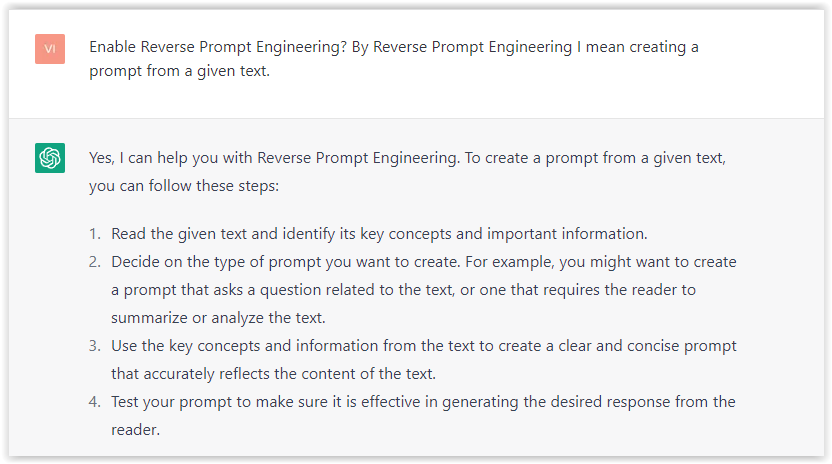 Screenshot from ChatGPT, March 2023
Screenshot from ChatGPT, March 2023You can test other GPT assistants available in the GPTs search engine if you want to use Google results.
Master Reverse Prompt Engineering
ChatGPT can be an excellent tool for reverse engineering prompts because it generates natural and engaging responses to any given input.
By analyzing the prompts generated by ChatGPT, it is possible to gain insight into the model’s underlying thought processes and decision-making strategies.
One key benefit of using ChatGPT to reverse engineer prompts is that the model is highly transparent in its decision-making.
This means that the reasoning and logic behind each response can be traced, making it easier to understand how the model arrives at its conclusions.
Once you’ve done this a few times for different types of content, you’ll gain insight into crafting more effective prompts.
Prepare Your ChatGPT For Generating Prompts
First, activate the reverse prompt engineering.
- Type the following prompt: “Enable Reverse Prompt Engineering? By Reverse Prompt Engineering I mean creating a prompt from a given text.”
 Screenshot from ChatGPT, March 2023
Screenshot from ChatGPT, March 2023ChatGPT is now ready to generate your prompt. You can test the product description in a new chatbot session and evaluate the generated prompt.
- Type: “Create a very technical reverse prompt engineering template for a product description about iPhone 11.”
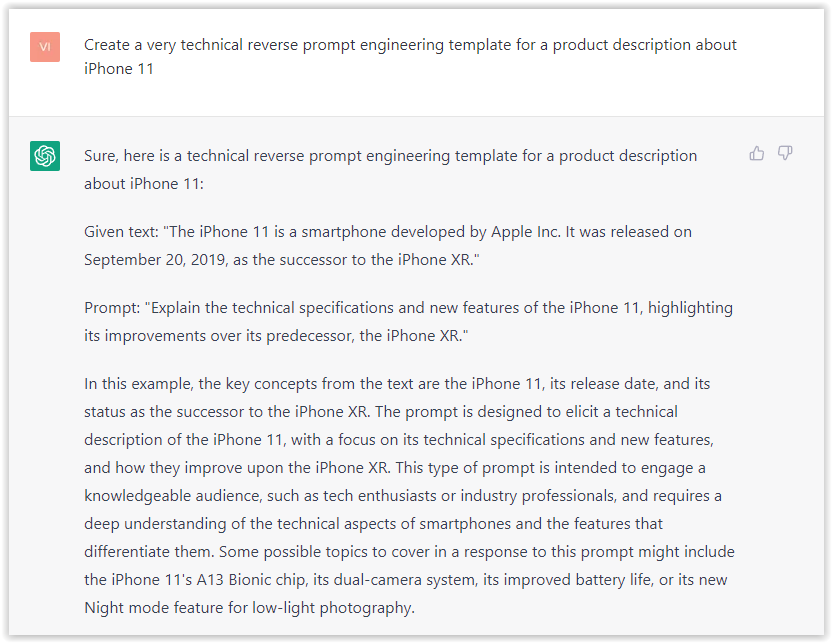 Screenshot from ChatGPT, March 2023
Screenshot from ChatGPT, March 2023The result is amazing. You can test with a full text that you want to reproduce. Here is an example of a prompt for selling a Kindle on Amazon.
- Type: “Reverse Prompt engineer the following {product), capture the writing style and the length of the text :
product =”
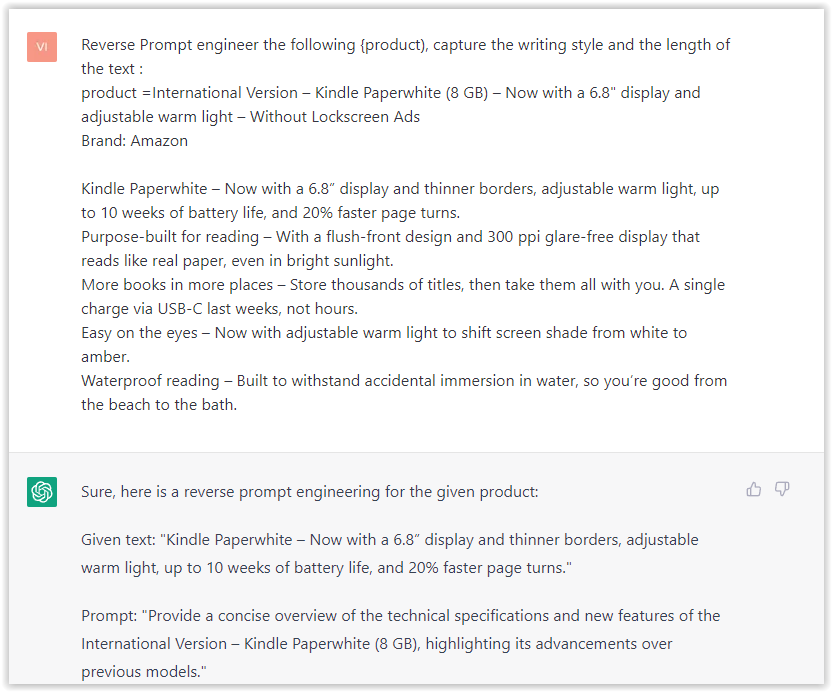 Screenshot from ChatGPT, March 2023
Screenshot from ChatGPT, March 2023I tested it on an SEJ blog post. Enjoy the analysis – it is excellent.
- Type: “Reverse Prompt engineer the following {text}, capture the tone and writing style of the {text} to include in the prompt :
text = all text coming from https://www.searchenginejournal.com/google-bard-training-data/478941/”
 Screenshot from ChatGPT, March 2023
Screenshot from ChatGPT, March 2023But be careful not to use ChatGPT to generate your texts. It is just a personal assistant.
Go Deeper
Prompts and examples for SEO:
- Keyword research and content ideas prompt: “Provide a list of 20 long-tail keyword ideas related to ‘local SEO strategies’ along with brief content topic descriptions for each keyword.”
- Optimizing content for featured snippets prompt: “Write a 40-50 word paragraph optimized for the query ‘what is the featured snippet in Google search’ that could potentially earn the featured snippet.”
- Creating meta descriptions prompt: “Draft a compelling meta description for the following blog post title: ’10 Technical SEO Factors You Can’t Ignore in 2024′.”
Important Considerations:
- Always Fact-Check: While ChatGPT can be a helpful tool, it’s crucial to remember that it may generate inaccurate or fabricated information. Always verify any facts, statistics, or quotes generated by ChatGPT before incorporating them into your content.
- Maintain Control and Creativity: Use ChatGPT as a tool to assist your writing, not replace it. Don’t rely on it to do your thinking or create content from scratch. Your unique perspective and creativity are essential for producing high-quality, engaging content.
- Iteration is Key: Refine and revise the outputs generated by ChatGPT to ensure they align with your voice, style, and intended message.
Additional Prompts for Rewording and SEO:
– Rewrite this sentence to be more concise and impactful.
– Suggest alternative phrasing for this section to improve clarity.
– Identify opportunities to incorporate relevant internal and external links.
– Analyze the keyword density and suggest improvements for better SEO.
Remember, while ChatGPT can be a valuable tool, it’s essential to use it responsibly and maintain control over your content creation process.
Experiment And Refine Your Prompting Techniques
Writing effective prompts for ChatGPT is an essential skill for any SEO professional who wants to harness the power of AI-generated content.
Hopefully, the insights and examples shared in this article can inspire you and help guide you to crafting stronger prompts that yield high-quality content.
Remember to experiment with layering prompts, iterating on the output, and continually refining your prompting techniques.
This will help you stay ahead of the curve in the ever-changing world of SEO.
More resources:
Featured Image: Tapati Rinchumrus/Shutterstock
SEO
Measuring Content Impact Across The Customer Journey
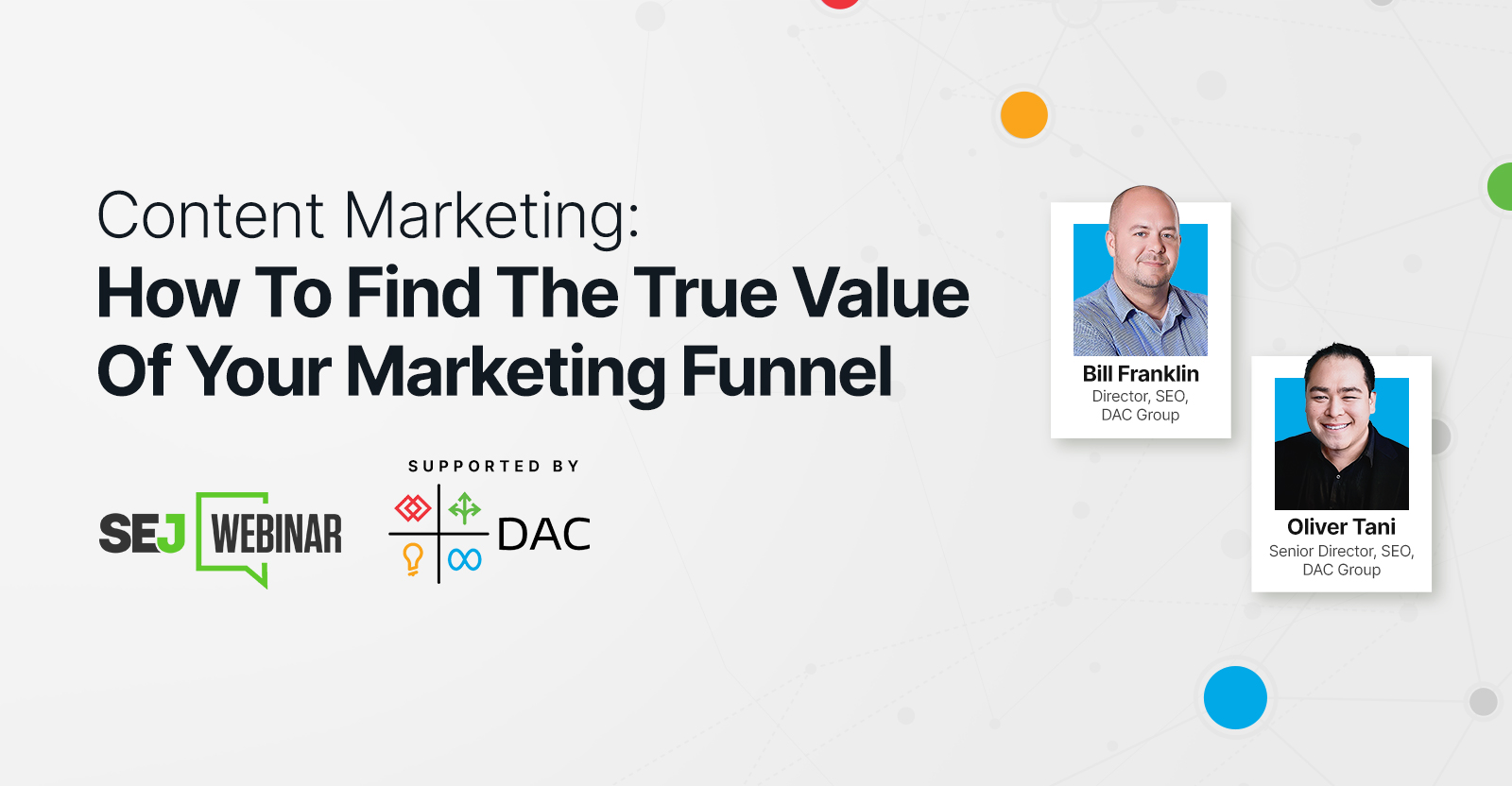
Understanding the impact of your content at every touchpoint of the customer journey is essential – but that’s easier said than done. From attracting potential leads to nurturing them into loyal customers, there are many touchpoints to look into.
So how do you identify and take advantage of these opportunities for growth?
Watch this on-demand webinar and learn a comprehensive approach for measuring the value of your content initiatives, so you can optimize resource allocation for maximum impact.
You’ll learn:
- Fresh methods for measuring your content’s impact.
- Fascinating insights using first-touch attribution, and how it differs from the usual last-touch perspective.
- Ways to persuade decision-makers to invest in more content by showcasing its value convincingly.
With Bill Franklin and Oliver Tani of DAC Group, we unravel the nuances of attribution modeling, emphasizing the significance of layering first-touch and last-touch attribution within your measurement strategy.
Check out these insights to help you craft compelling content tailored to each stage, using an approach rooted in first-hand experience to ensure your content resonates.
Whether you’re a seasoned marketer or new to content measurement, this webinar promises valuable insights and actionable tactics to elevate your SEO game and optimize your content initiatives for success.
View the slides below or check out the full webinar for all the details.
SEO
How to Find and Use Competitor Keywords
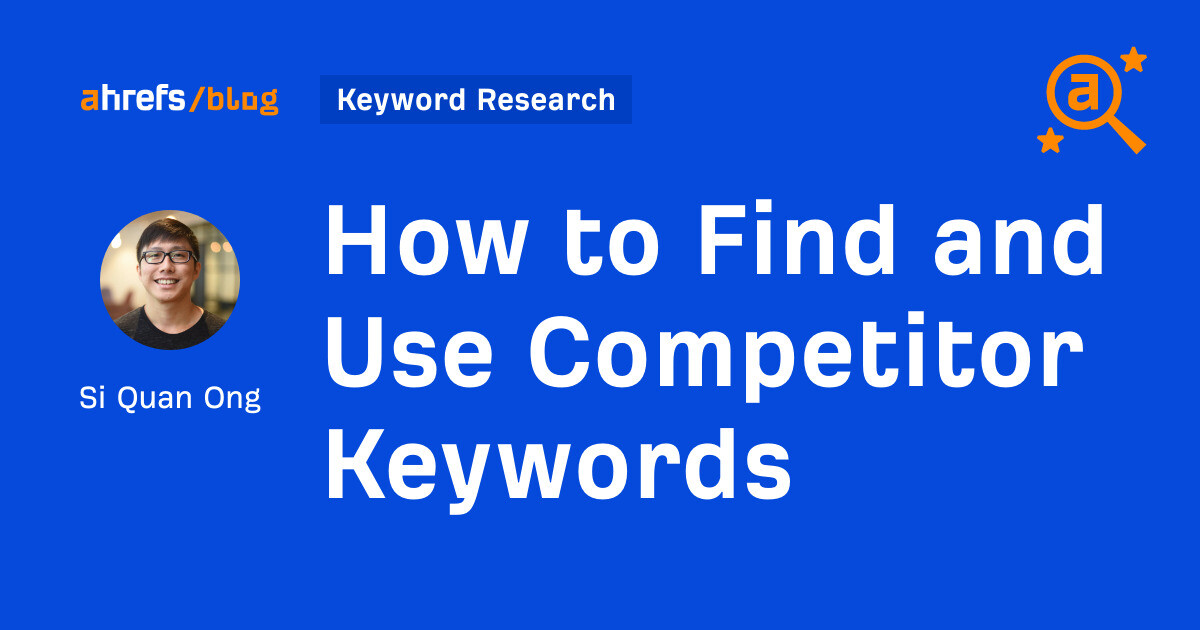
Competitor keywords are the keywords your rivals rank for in Google’s search results. They may rank organically or pay for Google Ads to rank in the paid results.
Knowing your competitors’ keywords is the easiest form of keyword research. If your competitors rank for or target particular keywords, it might be worth it for you to target them, too.
There is no way to see your competitors’ keywords without a tool like Ahrefs, which has a database of keywords and the sites that rank for them. As far as we know, Ahrefs has the biggest database of these keywords.
How to find all the keywords your competitor ranks for
- Go to Ahrefs’ Site Explorer
- Enter your competitor’s domain
- Go to the Organic keywords report
The report is sorted by traffic to show you the keywords sending your competitor the most visits. For example, Mailchimp gets most of its organic traffic from the keyword “mailchimp.”


Since you’re unlikely to rank for your competitor’s brand, you might want to exclude branded keywords from the report. You can do this by adding a Keyword > Doesn’t contain filter. In this example, we’ll filter out keywords containing “mailchimp” or any potential misspellings:
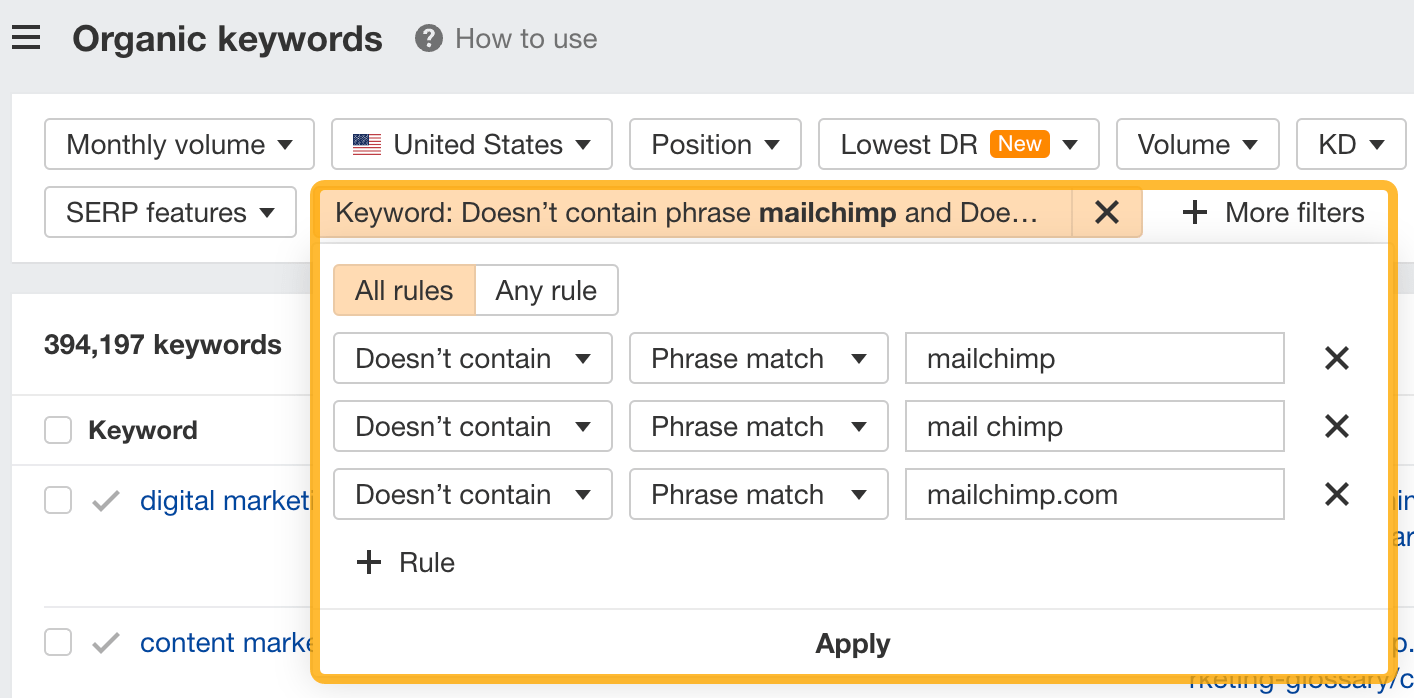

If you’re a new brand competing with one that’s established, you might also want to look for popular low-difficulty keywords. You can do this by setting the Volume filter to a minimum of 500 and the KD filter to a maximum of 10.
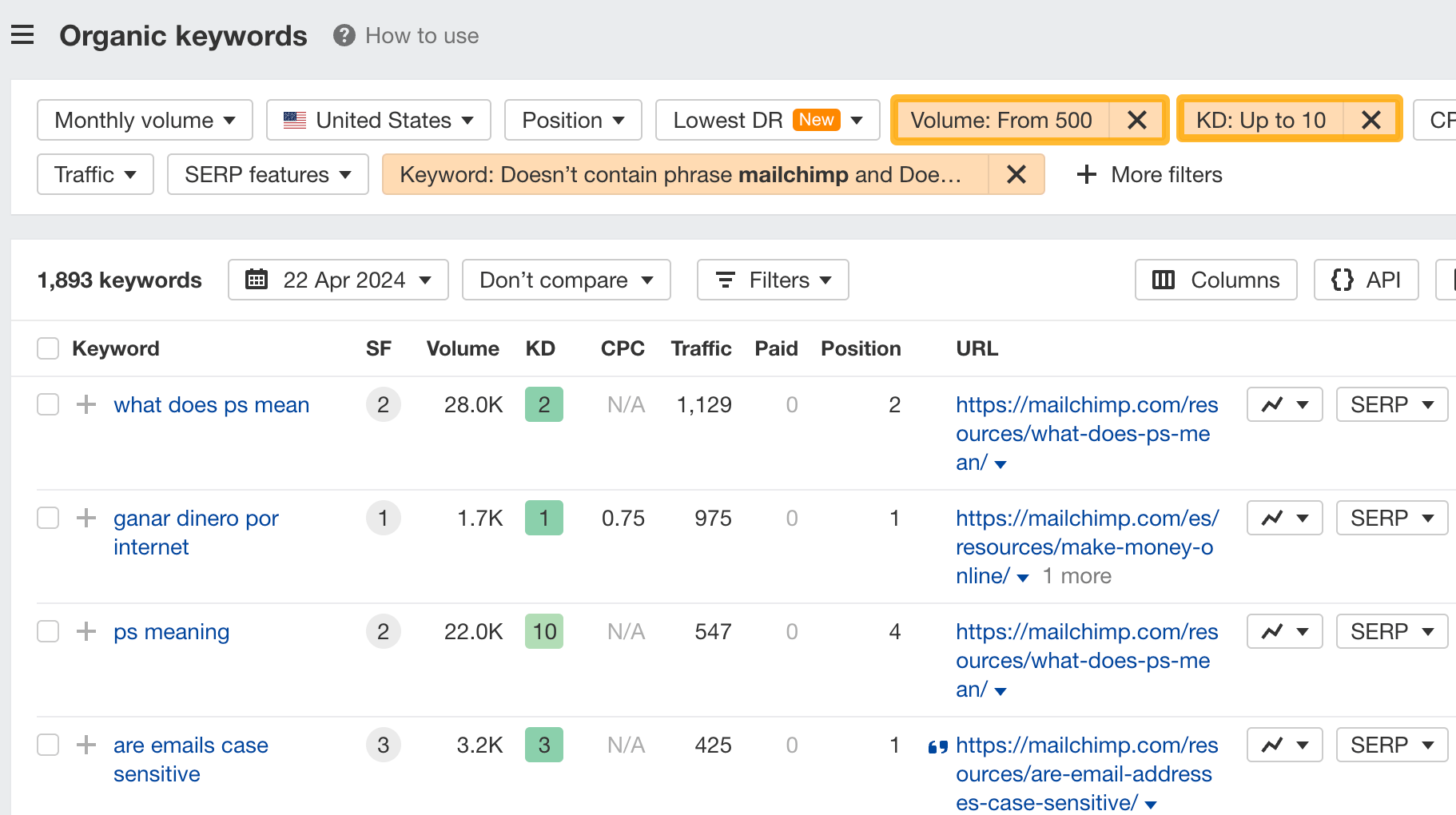

How to find keywords your competitor ranks for, but you don’t
- Go to Competitive Analysis
- Enter your domain in the This target doesn’t rank for section
- Enter your competitor’s domain in the But these competitors do section
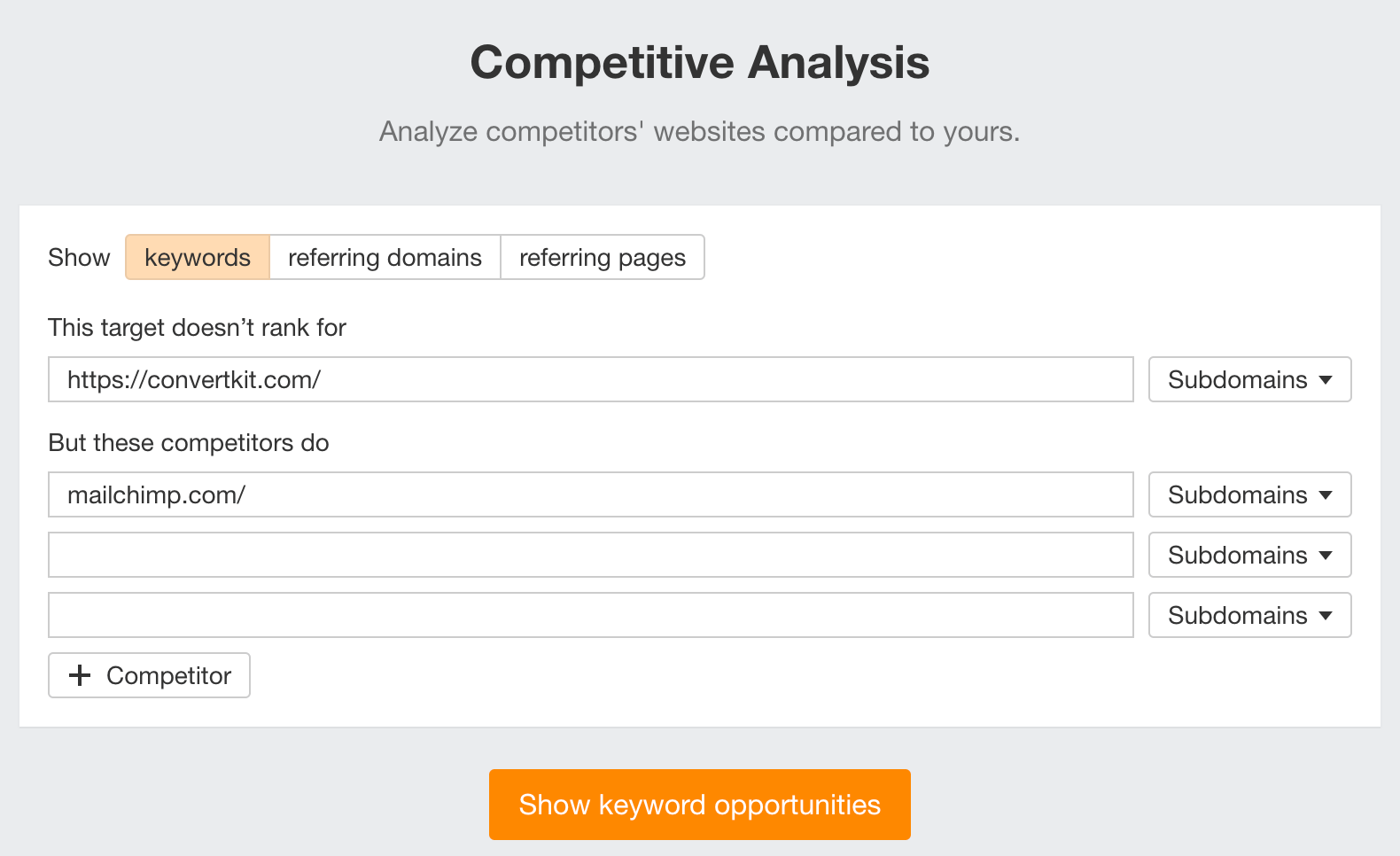

Hit “Show keyword opportunities,” and you’ll see all the keywords your competitor ranks for, but you don’t.
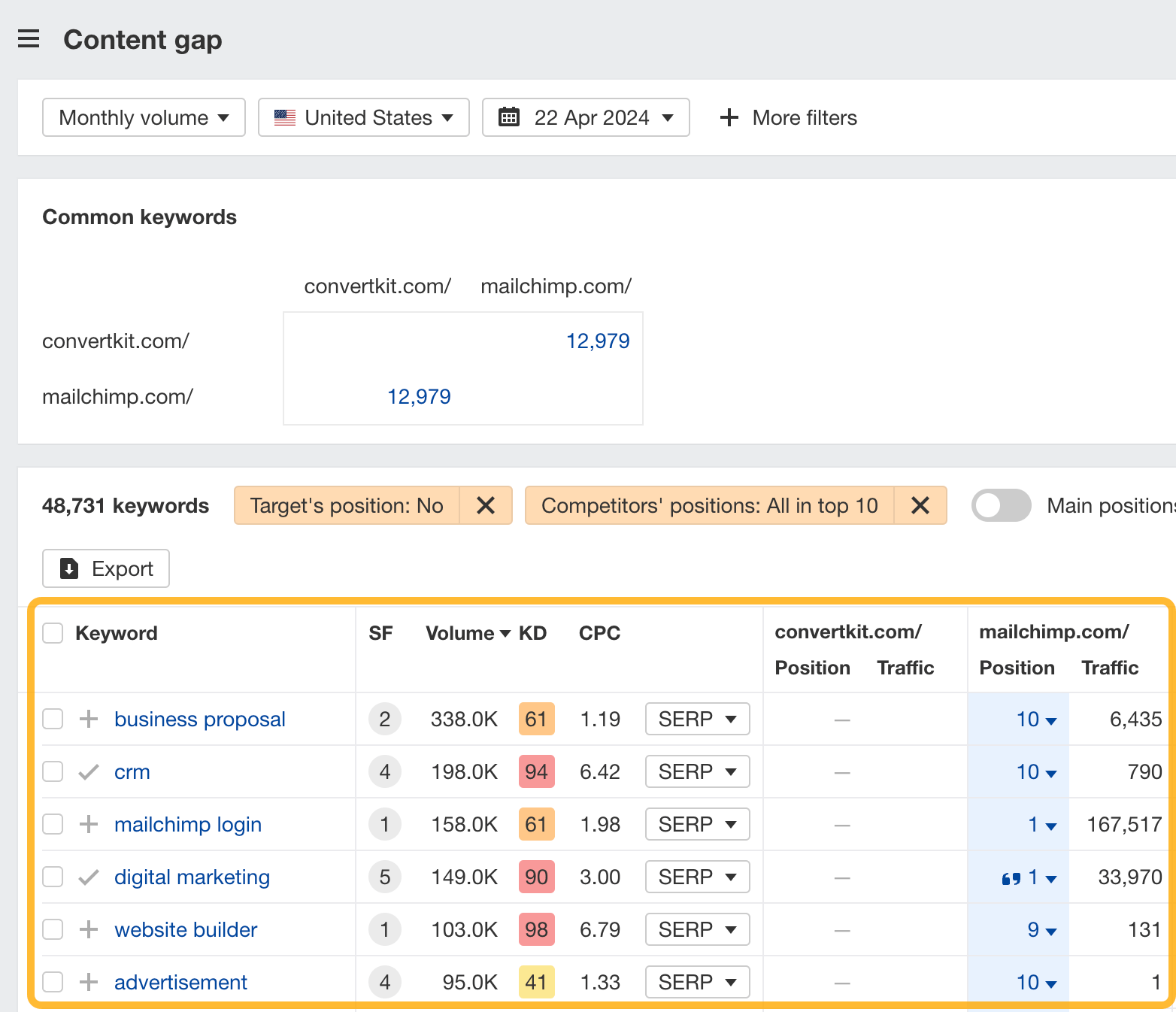

You can also add a Volume and KD filter to find popular, low-difficulty keywords in this report.
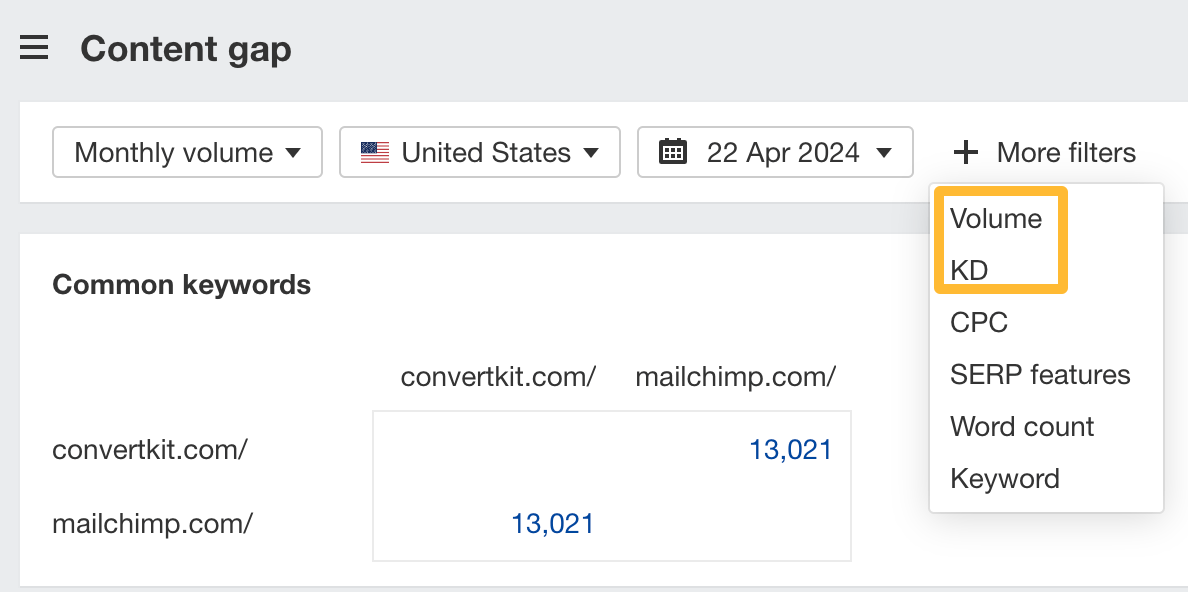

How to find keywords multiple competitors rank for, but you don’t
- Go to Competitive Analysis
- Enter your domain in the This target doesn’t rank for section
- Enter the domains of multiple competitors in the But these competitors do section
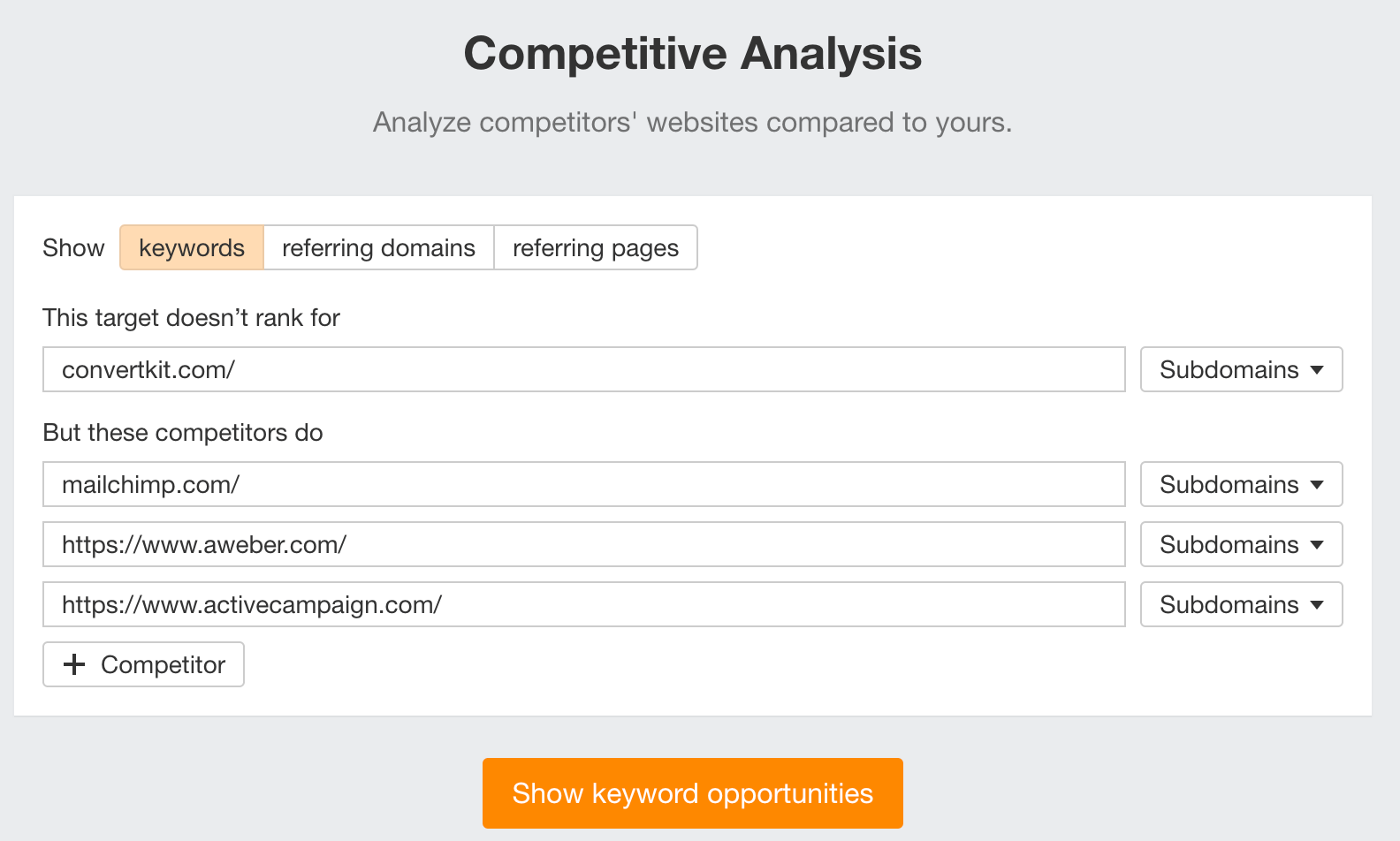

You’ll see all the keywords that at least one of these competitors ranks for, but you don’t.
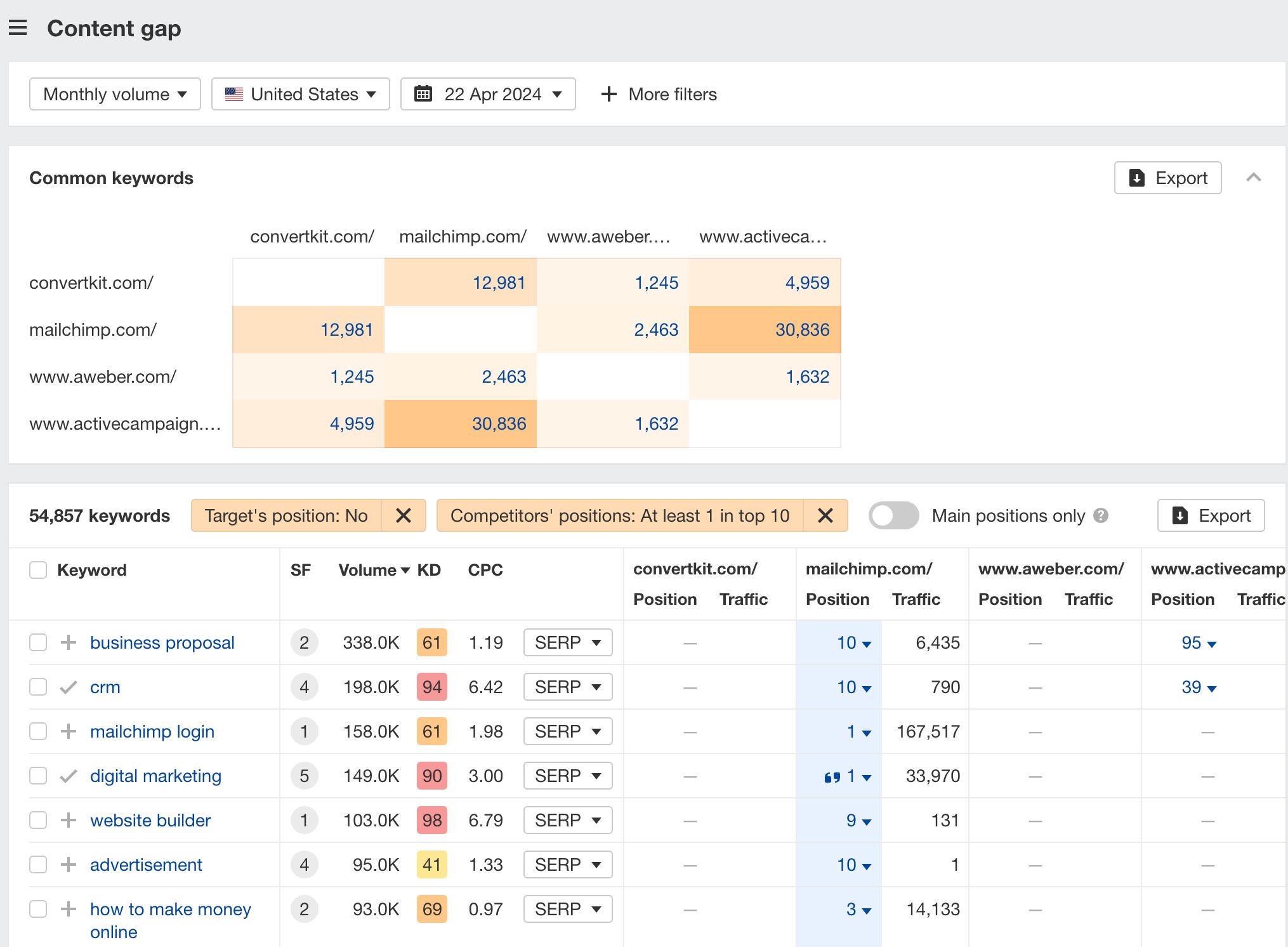

You can also narrow the list down to keywords that all competitors rank for. Click on the Competitors’ positions filter and choose All 3 competitors:
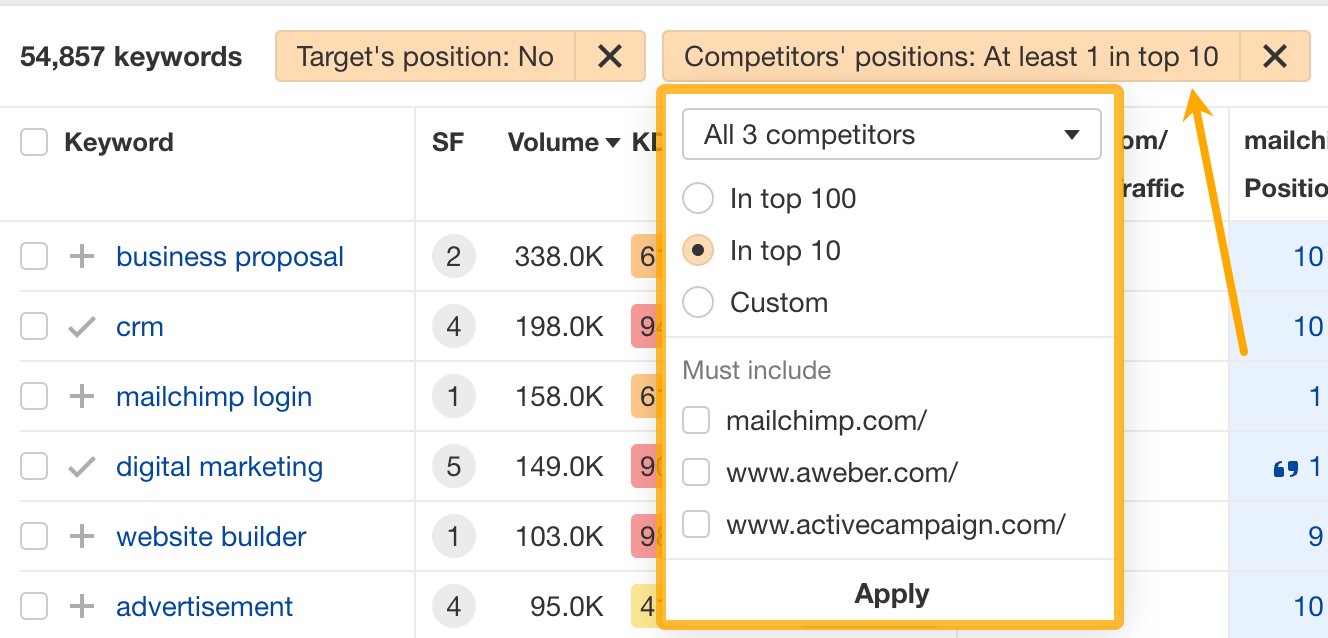

- Go to Ahrefs’ Site Explorer
- Enter your competitor’s domain
- Go to the Paid keywords report
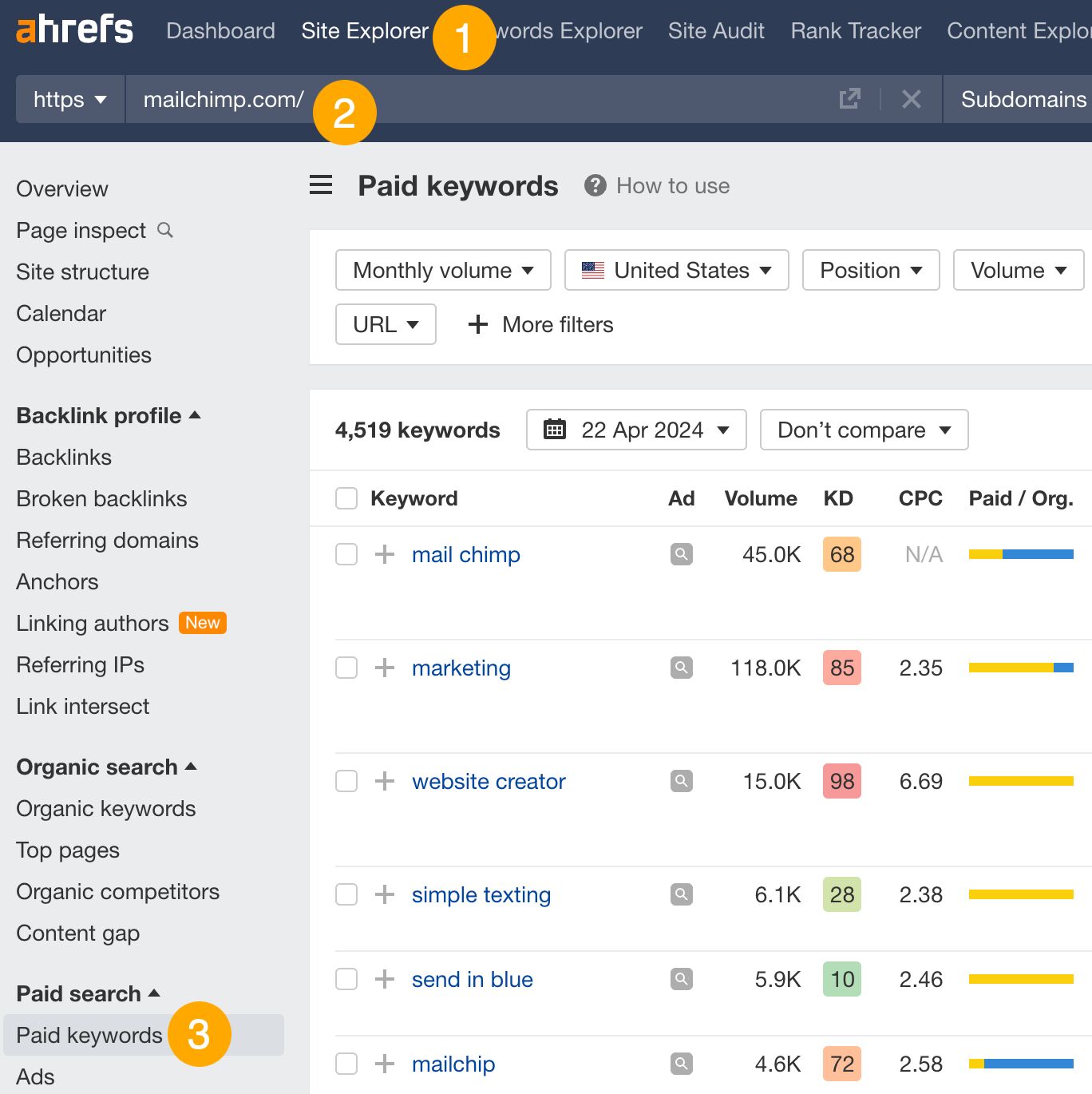

This report shows you the keywords your competitors are targeting via Google Ads.
Since your competitor is paying for traffic from these keywords, it may indicate that they’re profitable for them—and could be for you, too.
You know what keywords your competitors are ranking for or bidding on. But what do you do with them? There are basically three options.
1. Create pages to target these keywords
You can only rank for keywords if you have content about them. So, the most straightforward thing you can do for competitors’ keywords you want to rank for is to create pages to target them.
However, before you do this, it’s worth clustering your competitor’s keywords by Parent Topic. This will group keywords that mean the same or similar things so you can target them all with one page.
Here’s how to do that:
- Export your competitor’s keywords, either from the Organic Keywords or Content Gap report
- Paste them into Keywords Explorer
- Click the “Clusters by Parent Topic” tab
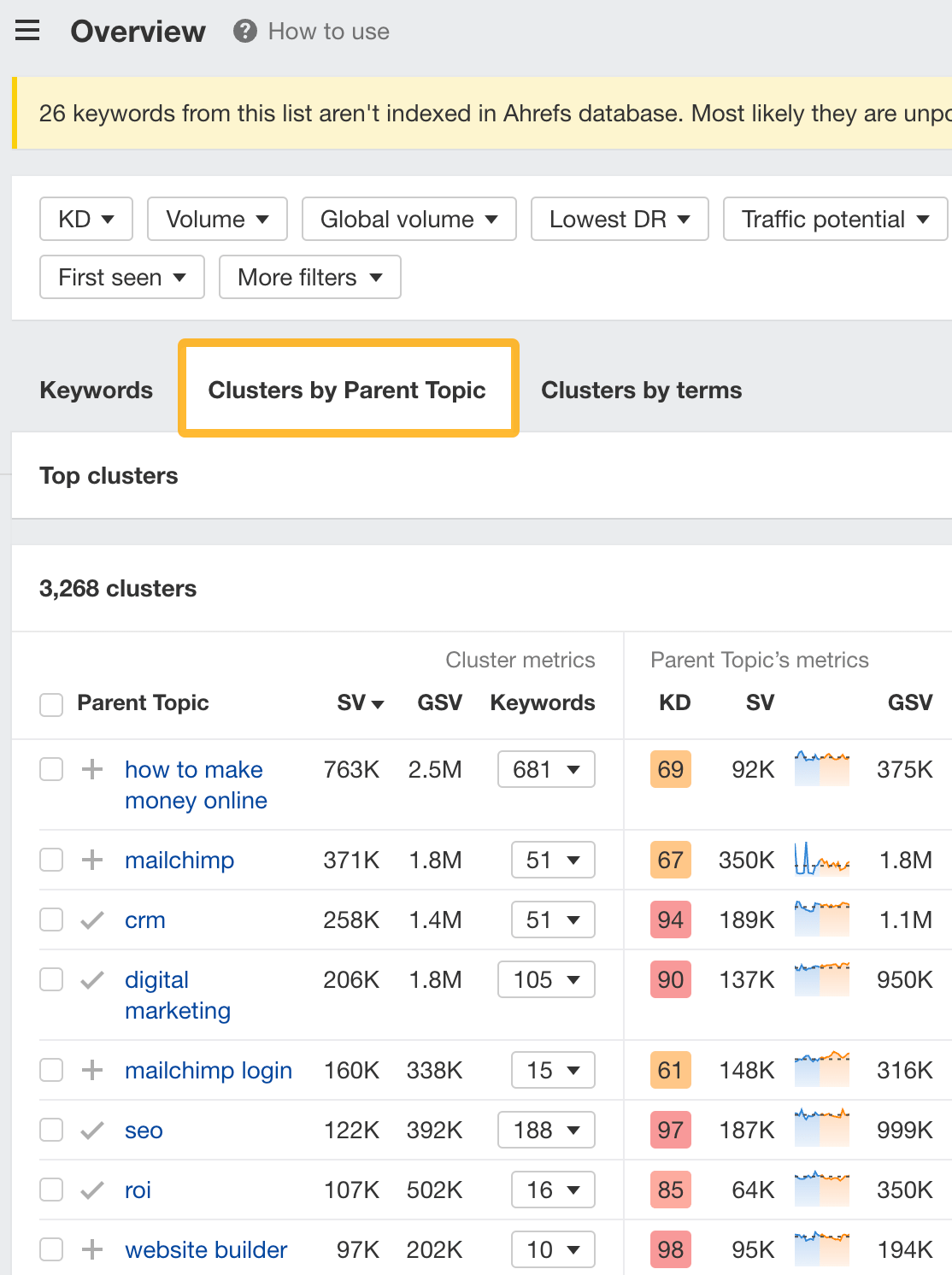

For example, MailChimp ranks for keywords like “what is digital marketing” and “digital marketing definition.” These and many others get clustered under the Parent Topic of “digital marketing” because people searching for them are all looking for the same thing: a definition of digital marketing. You only need to create one page to potentially rank for all these keywords.
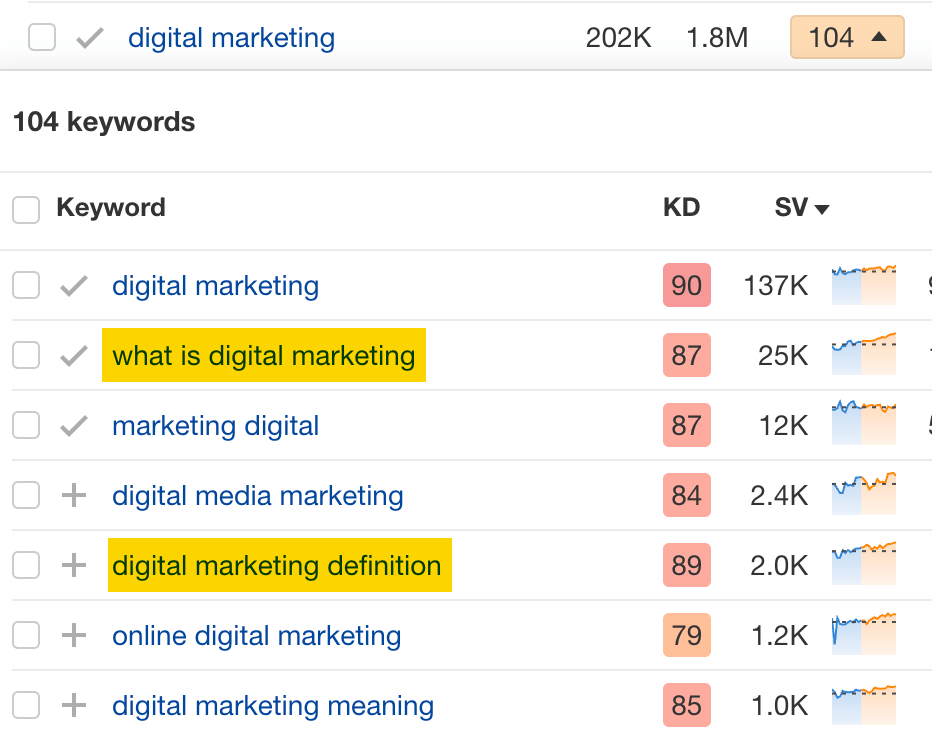

2. Optimize existing content by filling subtopics
You don’t always need to create new content to rank for competitors’ keywords. Sometimes, you can optimize the content you already have to rank for them.
How do you know which keywords you can do this for? Try this:
- Export your competitor’s keywords
- Paste them into Keywords Explorer
- Click the “Clusters by Parent Topic” tab
- Look for Parent Topics you already have content about
For example, if we analyze our competitor, we can see that seven keywords they rank for fall under the Parent Topic of “press release template.”


If we search our site, we see that we already have a page about this topic.


If we click the caret and check the keywords in the cluster, we see keywords like “press release example” and “press release format.”
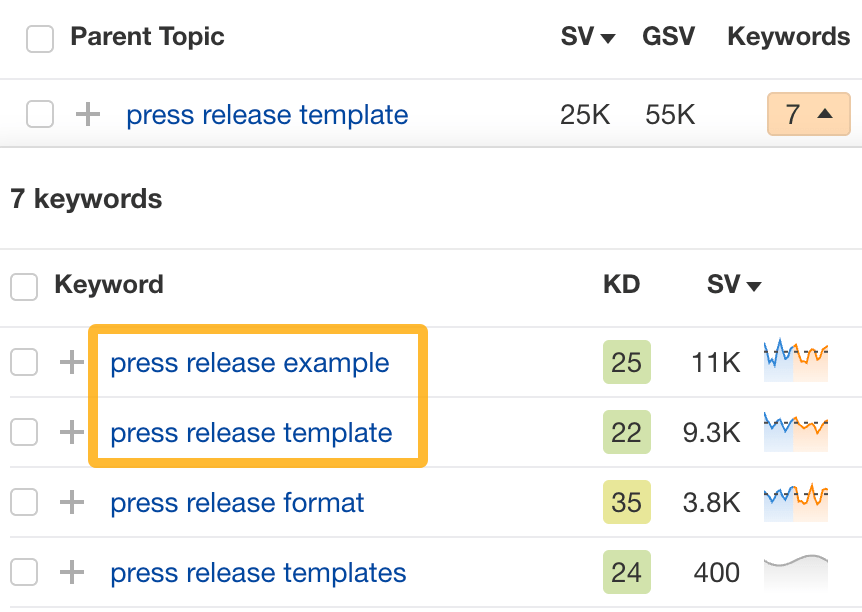

To rank for the keywords in the cluster, we can probably optimize the page we already have by adding sections about the subtopics of “press release examples” and “press release format.”
3. Target these keywords with Google Ads
Paid keywords are the simplest—look through the report and see if there are any relevant keywords you might want to target, too.
For example, Mailchimp is bidding for the keyword “how to create a newsletter.”


If you’re ConvertKit, you may also want to target this keyword since it’s relevant.
If you decide to target the same keyword via Google Ads, you can hover over the magnifying glass to see the ads your competitor is using.
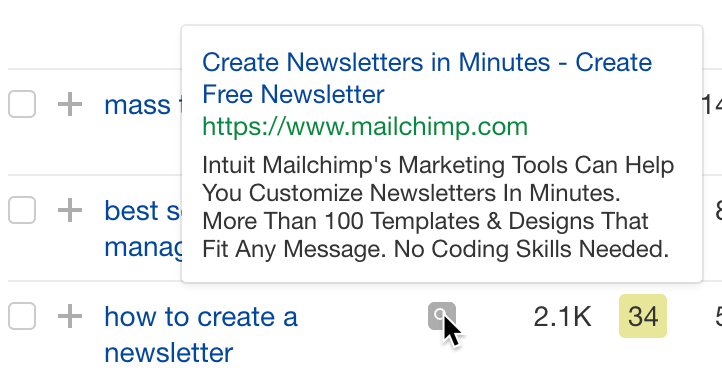

You can also see the landing page your competitor directs ad traffic to under the URL column.


Learn more
Check out more tutorials on how to do competitor keyword analysis:
-

 PPC5 days ago
PPC5 days ago19 Best SEO Tools in 2024 (For Every Use Case)
-
SEARCHENGINES7 days ago
Daily Search Forum Recap: April 17, 2024
-

 SEO7 days ago
SEO7 days agoAn In-Depth Guide And Best Practices For Mobile SEO
-
SEARCHENGINES6 days ago
Daily Search Forum Recap: April 18, 2024
-
SEARCHENGINES5 days ago
Daily Search Forum Recap: April 19, 2024
-

 MARKETING6 days ago
MARKETING6 days agoEcommerce evolution: Blurring the lines between B2B and B2C
-

 SEO6 days ago
SEO6 days ago2024 WordPress Vulnerability Report Shows Errors Sites Keep Making
-

 WORDPRESS5 days ago
WORDPRESS5 days agoHow to Make $5000 of Passive Income Every Month in WordPress















You must be logged in to post a comment Login